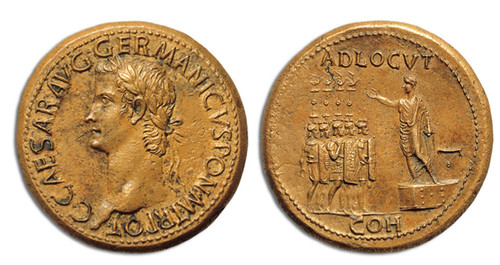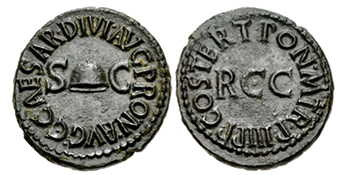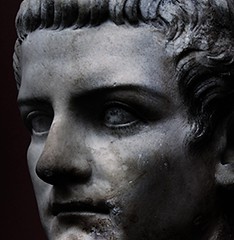
PREV ARTICLE
NEXT ARTICLE
FULL ISSUE
PREV FULL ISSUE
MARKOWITZ ON THE COINAGE OF CALIGULA
On July 28, 2015 Mike Markowitz published another nice article on the coinage of Caligula in CoinWeek, as part of his ongoing
Ancient Coin Series. Here's an excerpt. -Editor
When the reclusive, miserly and increasingly paranoid Emperor Tiberius died on 16 March 37 at the age of 78, most Romans greeted Caligula’s accession joyfully. Caligula’s early coinage celebrates his descent from his great-grandfather, the deified Augustus. Caligula’s laurel-crowned portrait appears on the obverse of his gold aurei and silver denarii surrounded by his titles. On one reverse, which bears no inscription, the head of Augustus, wearing the sun god’s spiky radiate crown, appears between two stars. Another type omits the stars and adds the inscription, “Divine Augustus, Father of the Nation.” On some examples, the portrait seems to have the features of the unpopular Tiberius, who was never deified by the Senate. Perhaps the mint engravers, who had copied and recopied the portrait of Tiberius for 22 years, automatically reproduced a familiar face. 
The orderly succession and survival of any Roman emperor depended on the Praetorian Guard, an elite force of bodyguards stationed in the capital. It was organized into nine battalions or “cohorts” each of 500 – 1000 men. On his accession, one of Caligula’s first official acts was to present each guardsman with a thousand sestertii bequeathed by Tiberius in his will, adding another thousand of his own. The reverse of a rare bronze sestertius, which may have been specially struck for this payment, shows Caligula standing on a platform with his arm raised in a formal gesture of greeting to a rank of guards. The abbreviated inscription ADLOCUT COH means “Address to the Cohorts.” Remarkably, this coin lacks the inscription SC (“by decree of the Senate”) which normally appeared on all Roman bronze coinage. An outstanding example of this type (“undoubtedly the finest specimen known”) brought over US$634,000 in a 2014 European auction. 
Perhaps the most enigmatic coin of Caligula’s reign was the smallest regular Roman denomination, the quadrans. It took 64 of these little coppers to equal the value of one silver denarius – a day’s pay for a manual worker. On the obverse, the emperor’s name and titles surround a “liberty cap” – the felt hat worn by freed slaves – bracketed by the letters “SC”. The reverse inscription continues the emperor’s titles, surrounding the large letters “RCC.” To read the complete article, see:
Wayne Homren, Editor The Numismatic Bibliomania Society is a non-profit organization promoting numismatic literature. See our web site at coinbooks.org. To submit items for publication in The E-Sylum, write to the Editor at this address: whomren@gmail.com To subscribe go to: https://my.binhost.com/lists/listinfo/esylum All Rights Reserved. NBS Home Page Contact the NBS webmaster 
|
